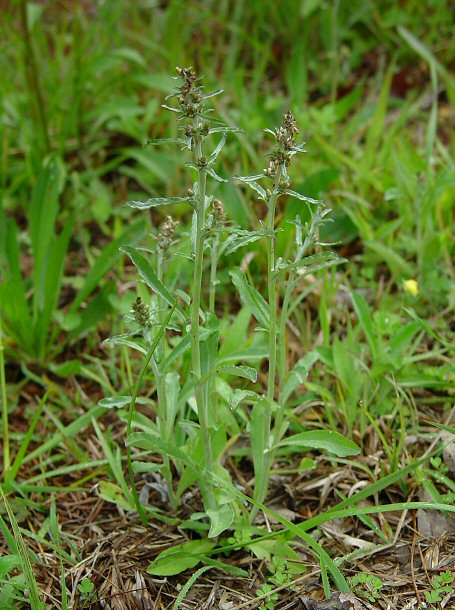Gamochaeta purpurea (L.) Cabrera
Purple Cudweed

Native
CC = 3
CW = 5
MOC = 49
© DETenaglia
Gamochaeta purpurea (L.) CabreraPurple Cudweed | |
 |
Native CC = 3 CW = 5 MOC = 49 |
© DETenaglia |
|
Family - Asteraceae/Gnaphalieae Habit - Annual or biennial forb with slender taproots, less commonly fibrous-rooted. Not aromatic. Stems - Ascending to erect, sometimes from a spreading base, to 45 cm, moderately to densely pubescent with woolly hairs.
Leaves - Alternate, basal leaves present or sometimes withered by flowering time. Leaves 1-6 cm long, sessile, simple, entire, oblanceolate to spatulate, the upper ones sometimes linear, strongly bicolorous, the upper surface sparsely woolly or with patches of cobwebby hairs, sometimes appearing nearly glabrous, the undersurface densely woolly, most or all of the hairs with a minute, swollen or expanded, transparent basal cell (this requiring 10x magnification to observe).
Inflorescence - Appearing as interrupted leafy spikes, with small clusters of heads axillary in the uppermost leaves and a short to somewhat elongate terminal spike, this sometimes reduced to a dense, conical or headlike mass in poorly developed plants, the individual heads sessile or minutely and inconspicuously stalked.
Heads - Involucre 4.0-4.5 mm long, the outermost bracts ovate-triangular with sharply pointed tips, the innermost lanceolate-triangular, tapered to a sharply pointed tip, covered with dense, woolly hairs that obscure all or most of the involucre. Receptacle flat or slightly convex at flowering, usually becoming shallowly concave at fruiting, naked. Florets - Marginal florets pistillate; central florets perfect. Ray florets absent. Disk florets with the corollas 2.5-3.5 mm long, usually white, often purple at the tip. Pappus of numerous capillary bristles, these fused at the base and shed intact as a ring, minutely toothed.
Flowering - April - June. Habitat - Prairies, glades, savannas, upland forest openings, tops of bluffs, streambanks, pastures, fields, roadsides, open, disturbed areas. Origin - Native to the U.S. Lookalikes - Other species of Gamochaeta, which are probably rare in Missouri. Other info. - This little species is often overlooked. It has little which resembles a flower without magnification. It occurs in somewhat scattered locations in Missouri, predominantly in the southern half of the state. It can be recognized by its overall canescent (hairy-gray) appearance, spatulate leaves which are woolly underneath, and muted flowering heads. Distinction of this species from the others of the genus in Missouri (G. argyrinea and G. pensylvanica) is difficult. Photographs taken somewhere in NC., 4-27-03 (DETenaglia); also at LaBarque Creek Conservation Area, Jefferson County, MO, 5-9-2017 (SRTurner). |